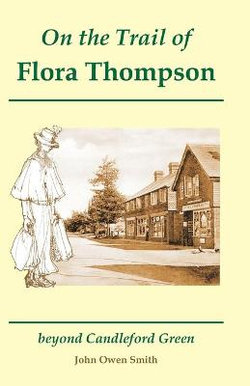Those of you familiar with Flora Thompson's work will recognise her habit of fictionalising the truth - when she wrote about the life of 'Laura' in "Lark Rise", it was of course about herself, Flora. She tells us of her family and the people around her, while changing their names and, to some extent, their history. This technique became an issue for Oxford University Press when they wished to take her work, since they did not normally publish works of fiction. But, recognising the merit of the book, they did accept it - and such was the demand from readers that they soon commissioned the sequels which became "Over to Candleford" and "Candleford Green". It is perhaps interesting to consider why Flora wove fact with fiction in the way she did. Sometimes it may have been to protect her own feelings, and sometimes to protect the feelings of others. It also allowed her the liberty of putting true events into more readable contexts - we know of several instances where a good yarn was reused in another piece of writing - and on her own admission she sometimes combined the characteristics of two or more people into one for the purposes of making a story.
But we should remember too that she wrote her main works more than forty years after the events she was describing - and who among us can remember precise details over that period of time? So from the perspective of the historian, her works have to be treated with care if used as sources of factual information. Her descriptions of life, particularly the life of ordinary rural people at the time of her youth, are considered to be some of the best available, and there is little doubt that the flavour and most of the detail which she gives us is entirely accurate. And yet if we try to relate her works to certain known historical facts, we can sometimes find ourselves on shaky ground. While investigating local history in my own part of the country, that area just west of the Weald where the three counties of Hampshire, Surrey and Sussex all meet, I tried to take Flora's legacy and add it to our other pieces of local knowledge. The work of chief interest to me was "Heatherley", which she completed in 1944 and was written as a sequel to "Candleford Green".
It is the true 'fourth volume' of the "Lark Rise trilogy", telling us about her period at Grayshott beginning a year after she left 'Candleford Green,' but for some reason she decided to leave it in typescript form and carried on instead with what was to be her last work, Still Glides the Stream, published posthumously in 1948, which did not continue the story of 'Laura.' The texts of "Heatherley" and her other unpublished works were seen by Margaret Lane soon after Flora's death, and mentioned by her in a biographical essay published in the Cornhill Magazine in 1957. But it was not until 1970 that Anne Mallinson, who had a specialist country bookshop in Selborne, Hampshire, visited Flora's birthplace, read a copy of this essay and realised its true significance to the literary heritage of her own part of the country. Here, along with Gilbert White, William Cobbett, George Sturt, WH Hudson and Edward Thomas, was another 'rural writer' describing times gone by in the West Weald area.
And when the centenary of Flora's birth came round in 1976, not only were there celebrations in Juniper Hill, but also Anne made sure there were celebrations in Liphook, where a 'literary lunch' was held in the Royal Anchor, attended by Margaret Lane among others. Alerted by the celebrations on the centenary, the Bramshott & Liphook Preservation Society subsequently worked with Anne to honour Flora's memory in the village more permanently, unveiling in 1978 a plaque on the wall outside the old Liphook post office where she had lived, and in 1981 a sculptured bust by Philip Jackson, which was subsequently moved into the village library in 1995. Although the biographical essay was reprinted once more for the centenary, the full text of Heatherley was still lodged in archives which had by that time been deposited at the University of Texas. Margaret Lane was encouraged to retrieve a copy of the typescript and prepare it for publication. This she did, including also some of Flora's poems and extracts from her "Peverel Papers" nature notes, producing a book called "A Country Calendar" and other writings, which was published by Oxford University Press in 1979.
Only then did the people of Grayshott begin to realise that, along with Arthur Conan Doyle, George Bernard Shaw and the other eminent writers who had based themselves in and around the village at the turn of the century, there had been yet another literary talent living unknown and quietly among them. These great men of letters had used her post office, and she had sold them stamps and transmitted their telegrams, all the time listening to their conversation and wishing 'that one of those quick, clever remarks they tossed like coloured balls into the air could have come her way.' But it never did so - and not one of them recognised that a kindred spirit stood there behind the counter. Though she stayed in Grayshott only 2 years, it was a significant chapter in Flora's life - her 'Sinister Street' years, when she felt she had first became an adult woman - and "Heatherley" tells us more, perhaps, about her character than her more famous writings do. Could this be one reason why she chose not to publish it herself? You must judge for yourself as we follow her trail ...



Share This Book: